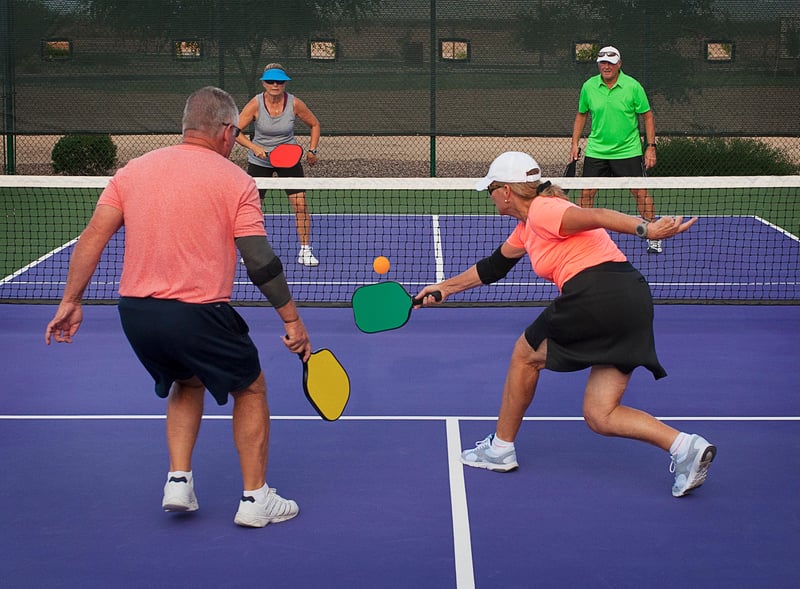Get Healthy!

- Cara Murez
- Posted July 12, 2023
As the Popularity of Pickleball Soars, So Do Related Injuries, Poll Finds
Pickleball is a hot trend and it's getting folks exercising who haven't been so active in a long time.
It's also racking up injuries -- both overuse type and acute traumas -- often in those aged 50 and up.
A new poll suggests these players are forgoing care when they hurt their knees, wrists and rotator cuffs. Sports medicine experts are urging them not to ignore their nagging pain.
Dr. Luis Gandara, a specialist in sports medicine at Orlando Health Jewett Orthopedic Institute in Florida, sees a few types of pickleball injuries, including those that are acute from a fall and those in which someone has aggravated chronic pain issues, such as existing arthritis in a hip or other joint.
"Then [there are] the other ones who enjoy it so much that they play either too many hours or play too many games in a row,"Gandara said. "And those are the ones that we see having the overuse type of injuries due to the time and span, or the improper use of the equipment, like the paddle's too heavy, improper mechanics or they may be using the wrong shoes to play."
About one-third of people surveyed last month in a new Harris Poll for Orlando Health reported avoiding sports or a hobby because of a nagging injury. Nearly half said it wasn't worth seeing a doctor for a sports injury they thought would heal on its own.
About 44% of respondents said it was too much work to make a doctor's appointment for an injury that wasn't too painful.
"In situations like a person, for example, had an acute injury and they cannot put weight on it, they cannot walk on it immediately or take more than three steps, in those situations it is recommended the patient be seen -- just to make sure they don't have a bad injury,"Gandara said.
Doing nothing can make that worse, he warned.
With a less acute injury that becomes more painful over time, a person may treat it with medication or ice for a week. If it persists, however, it's important to seek treatment so the injury doesn't worsen.
Robbin Murray turned to Gandara when she experienced knee pain that kept her off the pickleball court. Murray initially found a love for pickleball a decade ago, but her pain began as she played more often and in competition.
"I was hooked right from the start and would play as much as I could, all day long, eventually traveling to compete in senior tournaments,"Murray said in an Orlando Health news release. "It all added up and I started experiencing sharp pains that would take me down to the ground in the middle of a game."
She has been able to keep participating thanks to a specialized brace, anti-inflammatory injections and physical therapy that helped strengthen and stretch the area around her knee.
Dr. Jeffrey Berg, who practices sports medicine and arthroscopic surgery at Town Center Orthopaedics near Washington, D.C., said he, too, is seeing an uptick in pickleball injuries, especially among seniors.
"It's not all seniors, probably half and half now, but a good chunk of seniors that I think probably weren't nearly as active before, but pickleball lets you be competitive -- and, so, they've gotten excited about being competitive again,"he said.
"And I'll tell you, the patients that I see, all they care about is getting back to playing pickleball,"Berg added.
While it's good to be active, it's not good for anyone to go very quickly from inactivity to high activity, he said.
"I have seen some people with maybe unrealistic understanding of how to progress in an activity or how to be careful or how much to play" and how much not to play, Berg said. "Everything can be good, but there's a right dose for everything and sometimes in that person, they're just doing too much."
Routine losses in balance, strength, endurance, flexibility, coordination and eyesight that can come with aging can lead to falls. Falling when older can lead to more significant injuries, Berg said.
Before you begin, he suggests getting an evaluation from your primary care doctor.
Then, develop a base level of conditioning before trying something more advanced like a sport -- particularly a sport where a person may feel compelled to play even when they don't feel well because others are counting on them.
Berg said a beginning exercise program could include balance, flexibility, strengthening and aerobic conditioning.
When returning to exercise after injury, start slowly, he advised, and then slowly ramp up.
"If you're having pain while you're playing, there's a good chance you're probably making it worse and not better,"Berg said.
In general, Gandara recommends that people stay active, but for those restarting, he too recommends seeing a primary care doctor first.
Then, make sure you have the right equipment and understand the sport, he said.
"Always start slow and go slow,"Gandara said. "If you try to get into an activity too fast, too quickly, that's where your chances of getting an injury or having an overuse injury will start presenting."
The online survey was conducted June 15 to 20 among 2,076 U.S. adults aged 18 and older. It has a margin of error of plus or minus 2.7 percentage points.
More information
The U.S. Centers for Disease Control and Prevention has more on how older adults can add physical activity.
SOURCES: Luis Gandara, MD, sports medicine physician, Orlando Health Jewett Orthopedic Institute, Florida; Jeffrey Berg, MD, sports medicine and arthroscopic surgeon, Town Center Orthopaedics, Reston, Va.; Harris Poll for Orlando Health, June 15 to 20, 2023



